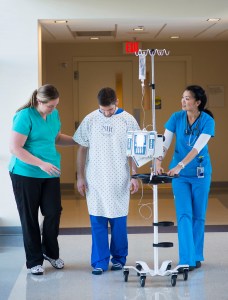Position Papers

The mission of the Physician-Patient Alliance for Health & Safety is to improve patient safety and the quality of patient care.
To reach these goals, PPAHS has developed and issued numerous position statements. These statements provide two key elements:
- Where We Are – A summary of what the current clinical trial and best practice evidence has shown are regarding the patient safety issue.
- Where We Need to Be – A statement on where clinical ought to be to improve patient safety and the quality of patient care.
Delays During COVID-19 in Respiratory Diagnosis Highlight Need for Safer Pulmonary Lung Function Testing
The COVID-19 pandemic has laid bare the dangers to both patients and their clinicians in testing and treating respiratory illnesses. This danger may occur when patients receive pulmonary lung function tests, such as spirometry which requires patients to exhale air out of their lungs. The results of the PPAHS survey on lung function testing shows that there is a need for improved technologies and procedures to measure lung dynamics and function that are outside of traditional pulmonary function testing (such as spirometry).
Black Lives Matter
We must act NOW to:
- Actively be anti-racist.
- Recognize that racism is not just a health disparity issue, but a societal issue that has a profound impact on ALL communities.
- Identify and call out racism, whether that it exists in ourselves, our neighbors, or in our leaders.
- Listen and follow black voices, like the Association of Black Cardiologists and the National Black Nurses Association.
To read the PPAHS Position Statement calling for racial equality, please click here.
2020 Healthcare Technology Predictions
In this annual report, we present 5 healthcare innovations and technology predictions for 2020 (the uses of technology discussed are not new, but we believe that their adoption, acceptance, and use will increase). This report also discusses what we at the Physician-Patient Alliance for Health & Safety (PPAHS) have done to foster innovation and technology adoption.
Patient Ambulation a Key Metric to Improved Health
Movement is a critical factor to improving patient health. Patient ambulation, the ability to walk from place to place independently with or without an assistive device, is necessary to improve joint and muscle strength, as well as prevent pressure ulcers during extended bed rest. It is a critical factor in improving patient well-being while in hospital, as well as reducing total length of stay.
Patients Receiving Opioids Must Be Monitored With Continuous Electronic Monitoring
This includes patients undergoing moderate and conscious sedation, or recovering from procedures and managing pain using a patient-controlled analgesia (PCA) pump, particularly those during the postoperative period. To read the PPAHS position statement on continuous monitoring, please click here.
Position Statement on Concomitant Use of Benzodiazepines and Opioids
One of the commonly overlooked complications to safe opioid administration is failing to account for the additive sedation effects of non-opioid medication. In recognition of these dangers, in August 2016, the FDA issued its strongest warning about combined use of opioids and benzodiazepines and issued another caution more recently on September 20, 2017.

To further emphasize that the concomitant use of benzodiazepines and opioids may be a deadly combination, the Physician-Patient Alliance for Health & Safety released a position statement, “Patients Receiving Benzodiazepines, in Combination with Opioid Analgesics, May Suffer from Respiratory Compromise and Death.”
Position Statement on Procedural Sedation

Although procedural sedation is generally safe, the Physician-Patient Alliance for Health & Safety recommends that all procedural sedation follow at least these five precautions:
- Administration of Procedural Sedation Must Be With Trained Personnel, Who SHOULD NOT Also Be Performing the Procedure
- Equipment and Supplies Must Be On-Hand in Case of Oversedation and Respiratory Compromise – and Clinicians Need to Practice How to Use Them!
- Early Detection of Respiratory Compromise Will Decrease Adverse Events and Patient Deaths
- All Patients Undergoing Procedural Sedation Should be Monitored with Capnography
- Recovery and Discharge of the Patient Must be Supervised by Trained Anesthesia Providers
To read the Position Statement on Procedural Sedation, please click here.
Clinical Toolkits
These toolkits may help improve patient safety and the quality of patient care:
- The New York State Partnership for Patients (NYSPFP) is a joint initiative of the Healthcare Association of New York State (HANYS) and the Greater New York Hospital Association (GNYHA)-hospital trade associations representing not-for profit and public health care institutions, including large health systems, acute and long-term care hospitals, skilled nursing facilities, hospices, and home care. Collectively, they represent all of the hospitals in New York State.
- This worksheet was “developed by NYSPFP in partnership with the Institute for Safe Medication Practices (ISMP)” and “provides opioid-related process improvement strategies for consideration as hospitals work to reduce adverse drug events.”
OB VTE Safety Recommendations – just some of the references that were used in developing these recommendations:
- Bourjeily G, Paidas M, Khail H, Rosene-Montella K, Roger M. “Pulmonary Embolism in Pregnancy”. Lancet 2010; 375; 500-12
- Centre for Maternal and Child Enquires (CMACE). Maternal obesity in the UK: findings from a national project, 2010.
- Bates SM, Greer IA, Middeldorp S, et al:” VTE ,Thrombophilia, antithrombotic therapy, and pregnancy. Antithrombotic Therapy and Prevention of Thrombosis”, 9th ed: American College of Chest Physicians Evidenced-Based Clinical Practice Guidelines Chest 2012; Feb.;141 (2 Supplement) e 6915-7365
- Ann Surg. 2004 February; 239(2): 162–171.doi: .1097/01.sla.0000109149.77194.6cPMCID: PMC1356208Copyright
- “Evidence-Based Compression Prevention of Stasis and Deep Vein Thrombosis “Rhys J. Morris, PhD and John P. Woodcock, PhD, DSc, CPhys, FInstP, FIPEM From the Department of Medical Physics and Bioengineering, University of Wales College of Medicine, Cardiff, Wales.
- James AH, Jamison MG, Brancazio LR,Meyers ER. Venous thromboembolism during pregnancy and the postpartum period: incidence, risk factors, and mortality. Am J Obstet Gynecol. 2006;194: 1311-5.
- James AH. “Pregnancy-associated Thrombosis”. Hematology 2009; 277-285.
- Giancarlo Agnelli, MD; Prevention of Venous Thromboembolism; prevention of venous thromboembolism in Surgical Patients. Circulation.2004; 110: IV-4-IV-12 Link: http://circ.ahajournals.org/content/110/24_suppl_1/IV-4.full
- Rodger, M. “Evidence Base for the Management of Venous Thromboembolism in Pregnancy.” Hematology 2010; 173-180.
- Will Lester, Nick Freemantle, Irena Begaj, Daniel Ray, John Wood, Domenico Pagano, “Fatal Venous Thromboembolism Associated With Hospital Admission-A Cohort Study to Assess the Impact of a National Risk Assessment Target”. Heart. 2013;99(23):1734-1739.
San Diego Patient Safety Council Patient-Controlled Analgesia (PCA) Guidelines of Care
- This toolkit was prepared by The San Diego Patient Safety Council, which consists of clinicians and healthcare professionals from acute care facilities across Southern California.
- Although it was prepared “to provide San Diego County Acute Care settings with recommendations for the standardization of intravenous Patient Controlled Analgesia (PCA) medication administration in the care of the opioid naïve patient”, we felt that you might find these recommendations useful.
- The STOPBang Questionnaire helps screen patients for obstructive sleep apnea (OSA).
- Twenty-four percent of men and nine percent of women are affected by OSA.
- According to researchers, “an estimated 82% of men and 92% of women with moderate-to severe OSA have not been diagnosed.”




